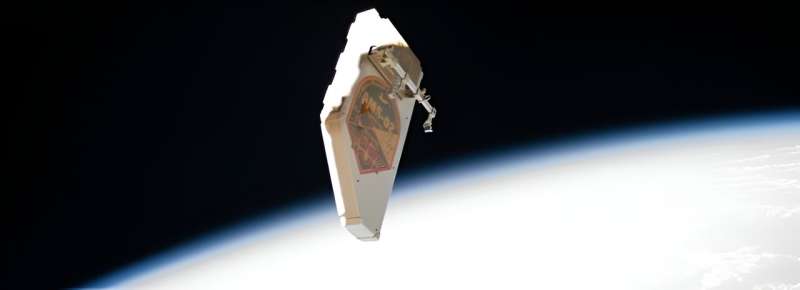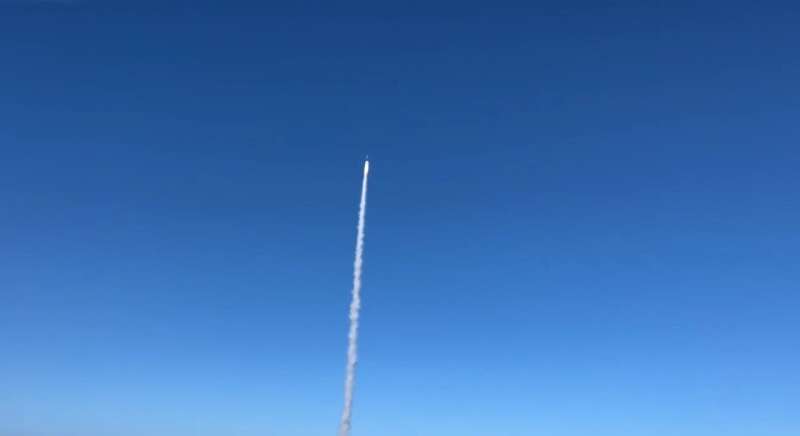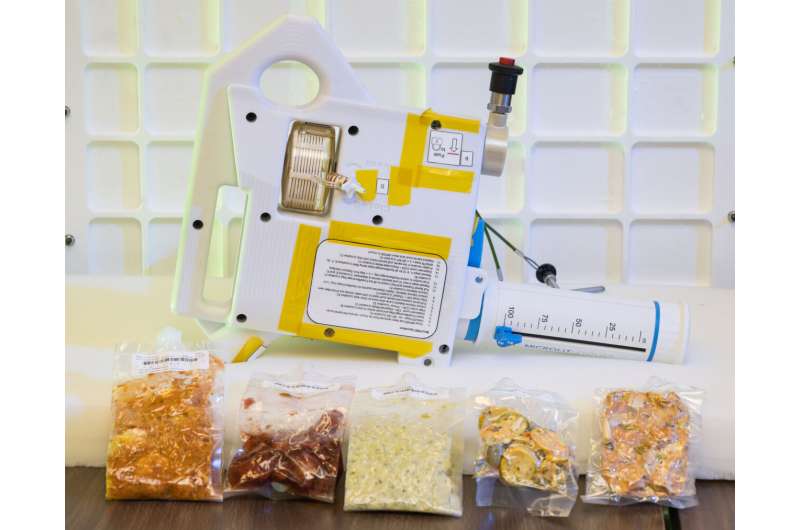Debris from DART impact could reach Earth
Friday, 06 September 2024 08:00
In 2022 NASA’s DART spacecraft made history, and changed the Solar System forever, by impacting the Dimorphos asteroid and measurably shifting its orbit around the larger Didymos asteroid. In the process a plume of debris was thrown out into space.
The latest modelling, available on the preprint server arXiv and accepted for publication in the September volume of The Planetary Science Journal, shows how small meteoroids from that debris could eventually reach both Mars and Earth – potentially in an observable (although quite safe) manner.
SpaceX launches third batch of satellites for NRO’s proliferated constellation
Friday, 06 September 2024 07:34

First metal part 3D printed in space
Friday, 06 September 2024 07:00 Image:
Image:
ESA’s Metal 3D Printer has produced the first metal part ever created in space.
The technology demonstrator, built by Airbus and its partners, was launched to the International Space Station at the start of this year, where ESA astronaut Andreas Mogensen installed the payload in the European Drawer Rack of ESA’s Columbus module. In August, the printer successfully printed the first 3D metal shape in space.
This product, along with three others planned during the rest of the experiment, will return to Earth for quality analysis: two of the samples will go to ESA’s technical heart in the Netherlands
Earth from Space: Sentinel-2 captures Sentinel-2
Friday, 06 September 2024 07:00 Image:
The Copernicus Sentinel-2B satellite captured this image over Europe’s Spaceport in French Guiana on 2 September, just ahead of the Sentinel-2C launch.
Image:
The Copernicus Sentinel-2B satellite captured this image over Europe’s Spaceport in French Guiana on 2 September, just ahead of the Sentinel-2C launch. China’s secretive reusable spaceplane lands after 267 days in orbit
Friday, 06 September 2024 06:27

Blue Origin racing to meet tight launch window for first New Glenn mission
Thursday, 05 September 2024 23:46

Aerospacelab opens doors to first US satellite manufacturing facility
Thursday, 05 September 2024 20:37
KBR’s latest acquisition boosts its classified space workforce amid growing military demand
Thursday, 05 September 2024 20:23

Managing space debris through space law
Thursday, 05 September 2024 19:41
It's becoming increasingly crowded in the orbits around Earth that are popular for space travel. And that's not just due to satellites—there's also more waste material, which is compromising safety. Ph.D. candidate Zhuang Tian is conducting research into the legal aspects of discarded space equipment. Whoever leaves debris behind should take responsibility and clean it up.
In the near future, probes with robotic arms will be hovering in orbit. The arms will have four metal tentacles spread out like a spider's legs, ready to catch a discarded satellite where the probes maneuver minutely. It's one of the techniques the company ClearSpace is currently simulating—only on Earth for the time being.
Active debris removal
With his specialization in space law, legal expert Zhuang Tian is following these developments closely. He will shortly be defending his Ph.D. thesis on the legal aspects of space debris disposal. The specific focus of his research is how companies like ClearSpace and the Japanese company Astroscale are planning on actively removing debris, because there is another option: space equipment that removes itself after use by burning into the atmosphere.
BOLT-1B hypersonic experiment soars and collects vital data
Thursday, 05 September 2024 19:32
The Boundary Layer Transition 1B (BOLT-1B) experiment, a joint research project of the U.S.
Viasat secures $153 million U.S. Army contract to modernize ‘Blue Force Tracker’ network
Thursday, 05 September 2024 17:32

A review of humanity's planned expansion between the Earth and the moon
Thursday, 05 September 2024 15:54
Between low Earth orbit and the moon, there is a region of space measuring 384,400 km (238,855 mi) wide known as Cislunar space. In the coming decades, multiple space agencies will send missions to this region to support the development of infrastructure that will lead to a permanent human presence on the moon.
This includes orbital and surface habitats, landing pads, surface vehicles, technologies for in-situ resource utilization (ISRU), and other elements that will enable the long-term exploration and development of the lunar surface.
For all parties concerned, Cislunar space holds immense potential in terms of scientific, commercial, and military applications. The vastly increased level of activity on and around the moon makes space domain awareness (SDA)—knowledge of all operations within a region of space—paramount.
It is also necessary to ensure the continued success and utilization of the covered region.
Artemis IV: Gateway gadget fuels deep space dining
Thursday, 05 September 2024 15:17
NASA engineers are working hard to ensure no astronaut goes hungry on the Artemis IV mission.
When international teams of astronauts live on Gateway, humanity's first space station to orbit the moon, they'll need innovative gadgets like the Mini Potable Water Dispenser.
Vaguely resembling a toy water soaker, it manually dispenses water for hygiene bags, to rehydrate food, or simply to drink. It is designed to be compact, lightweight, portable and manual, making it ideal for Gateway's relatively small size and remote location compared to the International Space Station closer to Earth.
Gateway's propulsion system testing throttles up
Thursday, 05 September 2024 15:14
The powerhouse of Gateway, NASA's orbiting outpost around the moon and a critical piece of infrastructure for Artemis, is in the midst of several electric propulsion system tests.
The Power and Propulsion Element (PPE), being manufactured by Maxar Technologies, provides Gateway with power, high-rate communications, and propulsion for maneuvers around the moon and to transit between different orbits.
The PPE will be combined with the Habitation and Logistic Outpost (HALO) before the integrated spacecraft's launch, targeted for late 2024 aboard a SpaceX Falcon Heavy. Together, these elements will serve as the hub for early Gateway crewed operations and various science and technology demonstrations as the full Gateway station is assembled around it in the coming years.
In this image, PPE engineers successfully tested the integration of Aerojet Rocketdyne's thruster with Maxar's power procession unit and Xenon Flow Controller.
Provided by NASA



